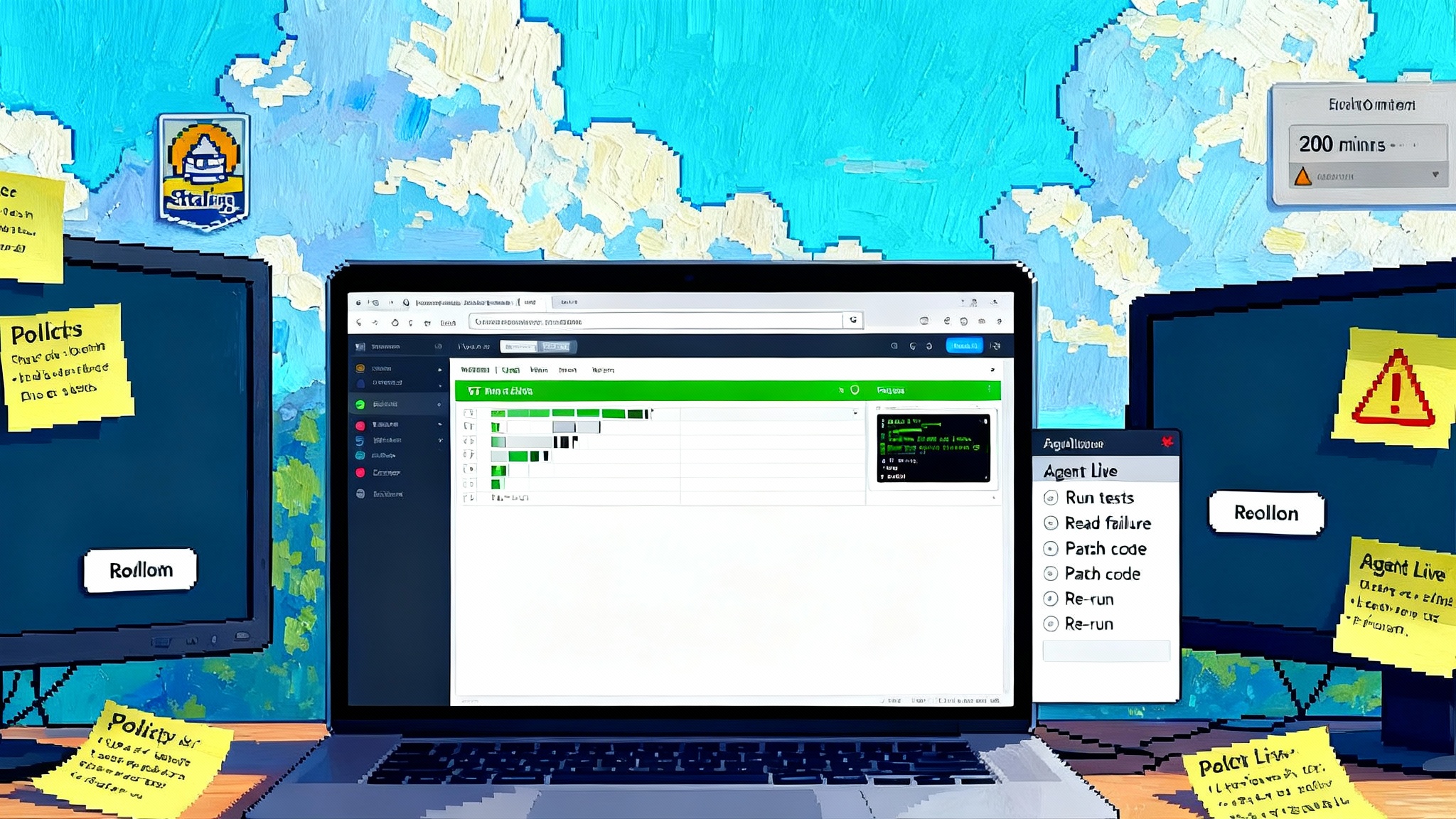Appy.AI turns agent demos into revenue-ready businesses
Appy.AI bundles payments, authentication, analytics, and white label sites into a conversational builder, turning agent ideas into sellable products in days and raising the bar for true end to end stacks heading into 2026.

The breakthrough: shipping the boring parts
A long standing bottleneck in the agent wave just cracked. For the past two years it has been easy to produce a clever agent demo and surprisingly hard to turn that demo into something customers can buy, access, and rely on. Appy.AI steps directly into that gap with a platform that guides an idea through a plain English build, then wraps it in the operational plumbing a real business needs. According to the public beta and funding round, the company emerged in October 2025 with a seed raise and a clear claim: it is not a prototype generator. It is a business creation stack.
That framing matters. The barrier to adoption is rarely a smarter prompt. It is everything that surrounds the prompt: pricing and payments, authentication and access control, analytics and reporting, a white label presence that speaks your brand, a support loop that customers can actually use, and a way to keep the whole thing running when models or requirements change. Appy.AI’s design makes those parts the default, not a scavenger hunt of third party integrations.
From demo to dollars: rails that make revenue possible
If you have ever tried to ship an agent that charges real money, you already know the checklist:
- Choose a model provider and set keys
- Add guardrails and basic observability
- Create a database that isolates per subscriber data
- Implement authentication and account recovery
- Set pricing and wire up subscriptions with taxes and refunds
- Host a brand forward landing page under a custom domain
- Instrument analytics for both usage and revenue
- Establish a support path that does not become an inbox swamp
None of this is glamorous. Each step is a chance for the project to stall. Appy.AI turns that list into the starting state. You describe your agent’s job in natural language. The platform scaffolds the behavior, stores data per subscriber, spins up a white label microsite, and lets you set a price and accept money without building your own billing layer. It includes access control, baseline analytics, and an in product support loop so you can close the feedback cycle on day one. The difference between a demo and a business is not intelligence. It is rails.
For a deeper sense of what is bundled, Appy.AI’s creator platform overview explains its approach to payments, account management, multi tenant data, and publishing.
What bundling looks like inside the product
Product bundling is not just a checklist. It changes how you work. Appy.AI begins by asking you to narrate the job in plain English. Think of it like briefing a new colleague on your client intake, your monthly analysis, or your onboarding routine. From there you add the inputs subscribers will provide, define recurring triggers such as a weekly report, and structure the data you want to retain per customer.
The result treats an agent not as a chat box, but as the nucleus of a small software business:
- A personal trainer describes a program once. The agent generates nutrition and workout plans per subscriber, sends a weekly check in, and tracks progress privately for each account.
- A mortgage broker defines an onboarding flow. The agent assembles document checklists and status updates per homebuyer, sitting behind a subscription rather than a free chat.
- A legal operations consultant encodes policy and templates. The agent checks documents against firm rules, logs outcomes by client, and keeps an audit trail the consultant can review.
The business logic lives in natural language, the commercial layer is built in, and the output is a fully packaged service that customers can reach without ever touching the underlying platform.
Why this matters for the long tail of micro software
The biggest audience here is not the classic app developer. It is the domain expert with a playbook that works in the real world: the coach who knows how to get a client to week three, the compliance specialist who knows which policy trips a workflow, the lab manager who knows the quiet steps that prevent errors, the wedding planner who knows how to keep vendors on time. These people can name a job, define success, and price the outcome. What they cannot justify is assembling seven vendors just to test an idea.
When payments and authentication are bundled, when analytics and support are bundled, the cost of trying drops from months to days, and sometimes to an afternoon. That is how the next wave of software arrives: not as giant suites, but as thousands of narrow services built by people who own an audience and understand a problem deeply. We have seen this pattern in adjacent corners of the stack. In legal, the push toward specialized orchestration is captured in our look at Harvey and the Agent Fabric. In engineering, the move toward self directed systems shows up in Replit Agent 3 shows autonomy. Appy.AI brings that same energy to the commercial last mile.
A tale of two builds: with and without bundling
Consider a nutrition coach who wants to sell a guided twelve week plan that adapts to each subscriber’s preferences and biometrics.
Without bundling, the coach must:
- Pick a large language model and maintain keys
- Build a web interface and a place to host it
- Add a database for measurements and preferences
- Implement authentication and password recovery
- Integrate a payments provider for subscriptions, trials, and refunds
- Create a marketing page and connect a custom domain
- Instrument analytics to track active subscribers, churn, and net revenue
- Choose a help desk and stitch it into the product
Nothing in that list is impossible. Nothing is fast. Each item burns time and introduces risk. This is why so many demo worthy agents never see a paying customer.
With bundling, the same coach narrates the plan, defines the onboarding questionnaire, chooses a monthly price, and publishes. The landing page appears under the coach’s brand. The agent writes weekly meal plans, stores data privately per subscriber, and triggers Monday check ins. When a plan is off track, the subscriber hits support inside the experience instead of a separate email thread. The coach logs in and sees active users and revenue in one place. That is not magic. That is product packaging that treats operations as a built in, not an afterthought.
Shipping velocity as a competitive signal
Platforms that matter ship visibly. Early table stakes include versioning, subscriber interactions, theming, and database tools. None of these items wins an award on its own, but together they widen the surface area for business use and reduce the odds that a creator hits a dead end. The deeper point is cultural. A platform that ships frequently is telling partners and power users that requests will not sit idle. In a market where the meaningful differentiators are often in the boring corners of the product, momentum becomes a trust signal.
That dynamic has shown up across the broader agent ecosystem. Where enterprises need governance and approvals, we have seen platforms lean into approval gated agents for MSPs. Where individual builders need revenue mechanics, the same lesson applies: ship the rails and the market notices.
What end to end will mean in 2026
“End to end” is about to get a tighter definition. By mid 2026, buyers will expect a stack that can ship a business in one place. The practical checklist will look like this:
- Conversational builder that captures business logic in plain language
- Integrated billing with trials, upgrades, taxes, and refunds
- First party authentication with role based access control
- Multi tenant data isolation for per subscriber storage
- White label presentation with custom domains and theme control
- Built in analytics that track usage and revenue together
- Observability for the agent, including inputs, outputs, and error handling
- A customer support loop that lives inside the product
- Automated deployment, versioning, and rollbacks
- Exportable logs and a clear audit trail for compliance
Enterprise platforms are already converging on agent orchestration. The consumer and prosumer tiers will follow with opinionated defaults. The difference between a platform that talks about agents and a platform that produces agent businesses is whether the list above is included, configured, and hard to break.
The lock in question, answered plainly
Platform lock in is a fair concern. Appy.AI’s documentation is direct that agents built on the platform run on the platform today. That trade is honest. In exchange for speed and less operational burden, you accept that portability is limited. Many domain experts will view that as an acceptable bargain because the alternative is never launching. Developers who prize full control should evaluate whether the revenue upside justifies the dependency and what the exit plan looks like if priorities change.
There are a few pragmatic ways to de risk the choice:
- Keep your business logic as narrative artifacts you can export and reuse
- Maintain a minimal schema of the customer data you must be able to extract
- Ask for a written explanation of how incident response and data isolation are handled
- Confirm that logs and reports can be exported on demand
Risks and how to evaluate them
Every bundled platform concentrates both convenience and risk. Here are the main areas to probe before you ship:
- Platform dependency. If the agent must remain on one platform, insist on strong uptime guarantees, an explicit SLA, exportable logs, and a documented plan for subscriber level data portability.
- Model drift and quality. If behavior can change as underlying models evolve, you need version control and the ability to freeze configurations, compare outputs across versions, and roll back safely.
- Pricing pressure. If usage fees track model costs, margins can evaporate. Favor predictable billing mechanics and a clear view into unit economics so you can price responsibly.
- Governance and compliance. If your sector has regulatory obligations, confirm audit trails, retention controls, and how personal data is handled. Ask for a plain language explanation of what third party model providers can access and retain by default.
What to do if you are a domain expert
If you own a repeatable playbook, you can likely turn it into a sellable agent powered service. Start small, then layer ambition.
- Identify a job that repeats. Pick something customers already pay for that reliably creates relief when done well. Relief is a pricing signal.
- Write a one page runbook. List the inputs you need, define what good looks like, and note what you do when things go wrong. That runbook becomes your conversational build.
- Start with onboarding. Ask only for the data you need to deliver a strong first outcome. You can always add fields later.
- Price simply. Monthly is fine. Annual with a discount is fine. Complex tiering is a distraction until you have real usage.
- Watch two numbers. Time to first paid subscriber and seven day retention. If those move the right way, keep going. If not, fix onboarding or adjust the job the agent actually performs.
What to do if you are an incumbent platform
Incumbents will feel this pressure quickly. Buyers will want fewer moving parts and a cleaner path from idea to invoice. To compete:
- Treat payments, authentication, analytics, and white label presentation as built ins, not optional integrations
- Close the loop inside the product so support, notifications, and upgrades feel native
- Replace vague agent talk with an opinionated model of a small business: product, price, account, data, page, support
- Publish changelogs and ship visibly so your ecosystem can plan around your momentum
The big picture
The story here is not another chat interface. It is the productization of the last mile. By bundling the dull but essential parts of a software business into a conversational build, Appy.AI compresses the path from idea to invoice. That unlocks a long tail of domain expert micro software and resets expectations for what an agent platform should deliver in 2026. For builders who can name a customer and a job worth doing, the distance between a demo and a business just got a lot shorter. For incumbents, the bar for end to end just moved upward.
If you are deciding where to invest your next week, consider this a nudge. Name the job. Write the runbook. Ship the rails. The remarkable part, the work that helps the customer, deserves to take center stage once the boring parts are handled.








